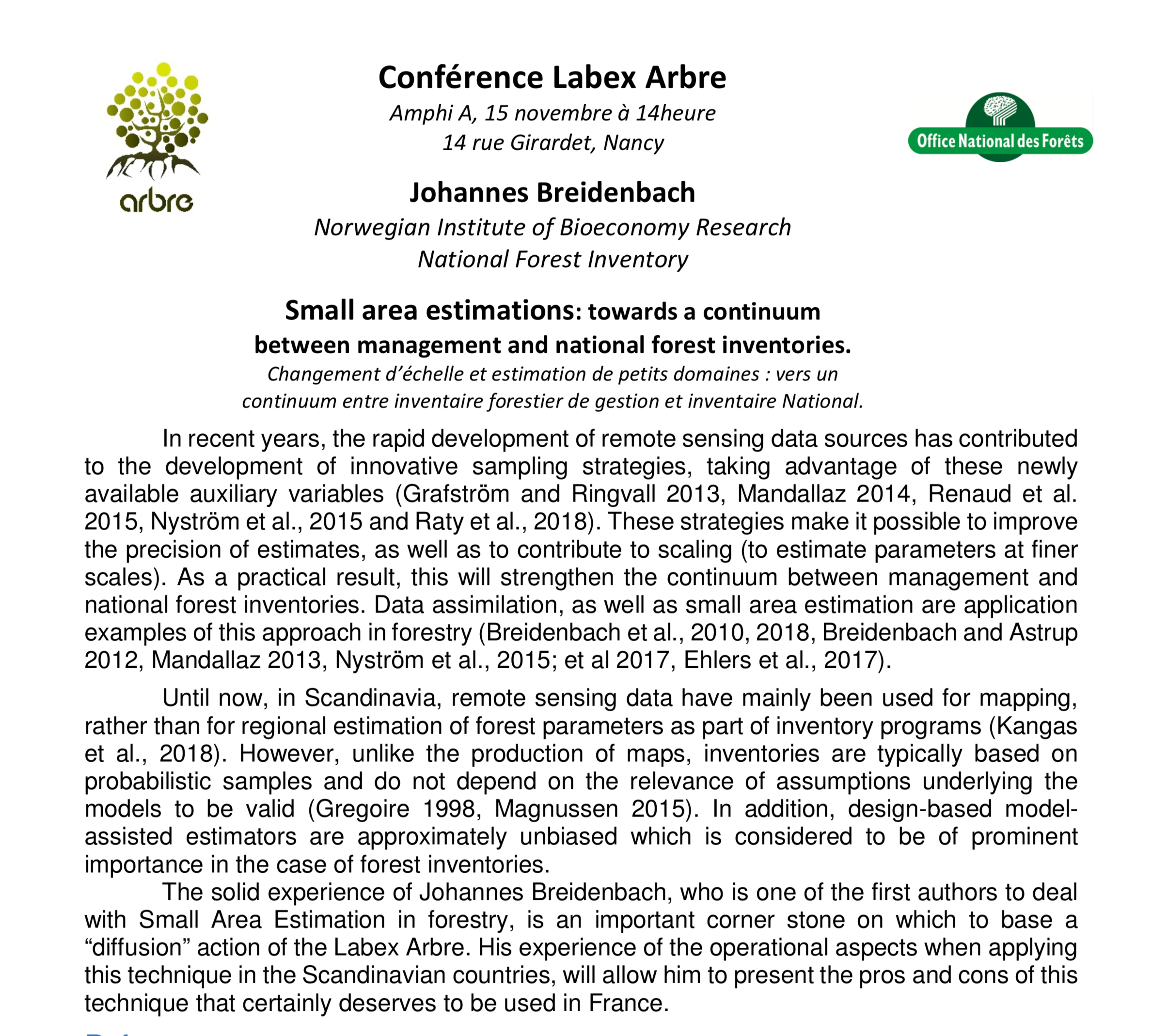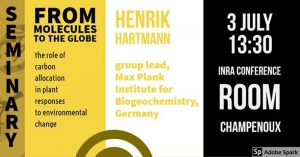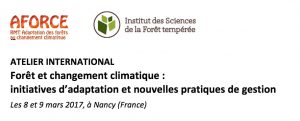
Seminar: Vanessa Haverd



On October 2nd & 3rd, scientists from the ONF, INRA and DSF will discuss the current knowledge on the biology and ecology of cockchafers to explore novel options to limit the insect outbreaks and their detrimental impact on forest regenerations.
The common and forest Cockchafer are two beetle species well known for the damages they can inflict to forest ecosystems. Whereas the adults may occasion spectacular defoliations to adult trees, the larvae also feed on the roots of young trees causing severe mortality in forest regenerations, further impacting the whole forest management process. Eastern European countries had been facing recurrent infestations since the 1960’s; in France, cockchafer populations seem to have turned from endemic to epidemic in the last 10 years, with dramatic damages reported in young forest stands of Picardie and Northern Alsace. In Germany, chemical treatments proved to be efficient in reducing populations and subsequent damages but their use is now forbidden. A wide diversity of alternatives had been investigated in Europe, mainly based on biological control methods. To date, these studies did not produce results that could be developed and ultimately applied in everyday forest management.
Forest managers now question the opportunity of modifying forest ecosystem parameters that are critical for the different phases of the cockchafer lifecycle. Such actions are likely to produce short-term efficient methods with limited environmental impacts. This project is based on a benchmarking approach of the acquired scientific knowledge of cockchafer biology and of thetechnical experiences accumulated in the European countries that have been subjected to outbreaks in the last decades. We aim at investigating whether changes in silvicultural management are able to limit cockchafer population dynamics.
Our first objective is to establish a state-of-the-art review of the knowledge concerning the environmental factors which determine cockchafer outbreaks. Then, our second objective is to propose a protocol to describe stand cover structure and ground vegetation characteristics which determine cockchafer larval density. These two objectives will initiate national and international networking on the research for solutions to cockchafer damages to forests.
Finally, the proposed project will provide a framework of hypothesis for the research of ecological solutions to prevent cockchafer outbreaks. This innovative project is likely to initiate a technical and scientific strategy for the management crisis caused by cockchafer outbreaks.


Ph.D. defense
Estelle Noyer “Réponses des perches de hêtre (Fagus sylvativa L.) à l’ouverture de la canopée : approche multidisciplinaire et multi-échelle.”
Friday 12 May at 9.30 am at AgroParisTech-Nancy (Amphithéâtre A).
Abstract: Opening of the canopy exhibits advantages (resources availability) but also new constraints (wind, higher evaporative demand). Rather well documented in saplings, response dynamics to canopy opening is less known in large trees. The thesis aims to identify the dynamics of responses to canopy opening in beech trees suppressed during long periods. Adopted approach is multi-disciplinary and multi-scale, based on a retrospective analysis of axial and radial growth, anatomy and biomechanical traits. For suppressed trees, the competition for light results in preferential allocation of biomass to axial growth in comparison with radial growth resulting in trees with high slenderness. Moreover, one third of suppressed trees are sagging. After the release, high slenderness presents a biomechanical risk: 15 from 36 trees are broken by the wind two years after the release. To increase their safety against the wind-break, trees reduce their axial growth during four years after the release and boost their radial growth reaching a stabilisation plateau after two years likely due to the size and resources limitations. Trees with lean angle higher than 6° up-right after the release. The tree ring hydraulic conductivity increases and stabilises after two year also. The dynamics of responses to canopy opening are therefore clearly trait dependent. Moreover, integrative approach highlighted the importance of size in the responses to canopy opening: while saplings adjust both wood tissue properties and tree geometry, large trees rely only on geometry adjustments.
Key-words : Fagus sylvatica, growth, biomechanics, anatomy, canopy opening, wood.
Faculté des sciences, Amphitheater 8, Vandoeuvre-lès-Nancy, Université de Lorraine
March 29-31, 2017
Redox regulation referred to as post-translational modifications affecting protein cysteine residues is of great importance for many biological processes. A milestone was the discovery in the 70s that photosynthesis is regulated at several entry points by such modifications. However, over the last decade, it has become obvious in all organisms that additional cellular functions and signaling pathways are controlled by redox changes, some of these being relevant for human health or microbial development and virulence. This redox biology symposium is the third of a series initiated in 2013 in Kaiserslautern followed by a second edition in 2015 already in Nancy. This edition will deal with redox regulation in eukaryote and bacterial systems with emphasis on plants as it is organized in the honor of Pr Jean Pierre Jacquot, who has made pioneering discoveries in this field and will officially retire in 2017.

“The soil bacterium Myxococcus xanthus is best known for its ability to build multicellular fruiting bodies. This form of social development has been shown to be prone to ‘cheating’ behaviour by asocial clones. Previous work has mainly been based on laboratory strains. In this talk, I will describe work on the genetic, phenotypic and behavioural diversity of natural populations of this fascinating species.”
Dr. Vos is invited by the Department DynAMic and his lecture is given within the Master BioMANE program. The seminar is sponsored by the LabEx ARBRE.
________________________________________________________
Thursday, 8 December 2016
Faculté des Sciences et Technologies
Vandoeuvre-lès-Nancy
Amphithéatre 8
The Center for Agronomic Innovation (Carrefour de l’Innovation Agronomique – CIAg) has gained recognition for offering research institutions (INRA and other research and development centers geared toward innovation) a valued platform for disseminating new projects and research results. Through a series of topic-specific forum discussions structured to foster productive and informative exchanges between researchers and actors in private sector development, the CIAg has become an important contributor at the crossroads of socio-economic changes currently taking place in industry and the French territories.
INRA has organized an upcoming CIAg forum dedicated to the emergence of a bio-based economy for forest and wood. This event will take place on December 8, 2016 at the Faculty of Science in Vandoeuvre-lès-Nancy. This CIAg forum will involve AgroParisTech Nancy and the University of Lorraine, with support from LabEx ARBRE.
While France is at the forefront in Europe in terms of wood production, trends in net trade balance have shown a decades long chronic deficit (currently close to 6 billion euros per year). In this context, the investment initiative Research Innovation 2025 proposes a series of innovation actions for the forest-wood industry which take into account not only new uses for wood and the role of ecosystem services, but also sets out a new vision towards developing research-innovation relations in this sector
In particular, newly developed concepts focused on the bioeconomy, involving the circular economy, and accounting for cascading value of products, by-products and non-linear interactions between sector actors, together offer a comprehensive analytical framework that could potentially breathe new life into the industry. The CIAg will aim to revisit and illustrate innovation issues related to forest resource management and wood uses.
Registration is free and is open through October.
For more information..
LabEx ARBRE will hold is annual conference this year on 18 October 2016. Special focus will be given to research results from numerous multidisciplinary projects selected from the annual ARBRE call for proposals, those from knowledge-transfer projects funded within the framework of the 2015 ARBRE-RMT AFORCE joint call for proposals, recently launched actions connected to the upcoming merger between the BEF and LIF labs and to scientific mediation projects.
For the detailed meeting agenda please click here :Colloque annuel ARBRE 2016_ programme final